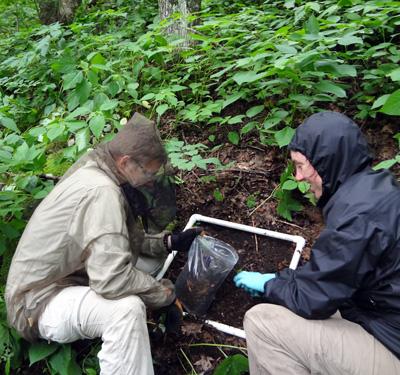Impacts of Acidic Deposition and Soil Calcium Depletion on Terrestrial Biodiversity and Food Webs in Northern Hardwood Forest Ecosystems

Decades of acid rain have caused depletion of calcium from forest soils in many areas across the Northern Forest region. Because calcium is essential to all organisms, NSRC researchers investigated how calcium loss affects soil fauna and forest food webs. Researchers studied upland forests ranging from nutrient-rich (less acidic) to nutrient-poor (very acidic) in New Hampshire, Vermont, and New York. They collected snails, soil arthropods, and salamanders from the forest floor and analyzed their abundance, diversity, and nutritional value in the food web, in relation to soil and plant nutrition.
Researchers found that snail species diversity and abundance increased with higher calcium nutrition of foliage and soils. Aluminum, which is toxic to snails and may be exacerbated by acid rain impacts, had the strongest overall effects on snail communities, but a few species were tolerant of high aluminum. Arthropod groups were less sensitive to soil chemistry and calcium availability. Several calcium-rich prey groups for salamanders and songbirds persisted in habitats with low calcium and high soil acidity. Contrary to past findings, the redback salamander, a keystone species in the Northern Forest, does not appear to be sensitive to soil acidity, based on population surveys of 36 sites across the region.
Acid rain may have reduced biodiversity in some forests, but functioning soil communities and food webs persist on acidified sites. Species tolerant of acid-mediated changes in soil chemistry and plant nutrition may be essential for maintaining calcium supply in food webs that include songbirds and other wildlife. Forest land use practices should consider impacts on soil fauna diversity.
